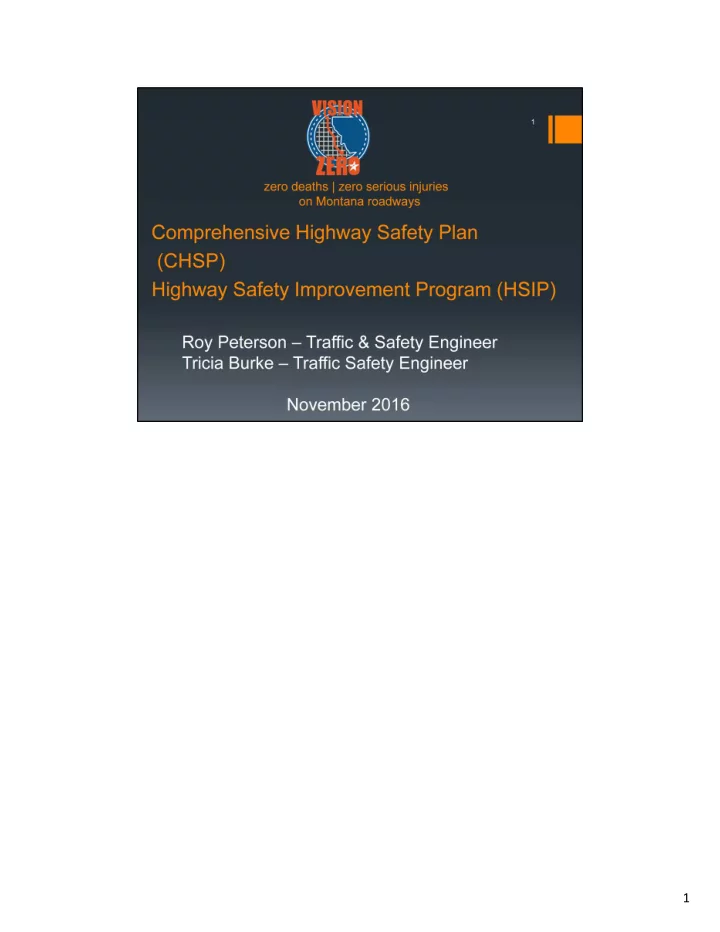

1
2
3
4
5
MDT took the lead in developing Montana’s first Comprehensive Highway Safety Plan (CHSP). However, highway safety is not the responsibility of a single agency and the CHSP is a collaborative, data ‐ driven approach to reducing fatalities on Montana’s highways. The vision used to be in the previous plan is “All highway users arrive safely at their destination”. The current vision is “VisionZero – Zero Deaths, Zero Injuries” The older plan included 12 emphasis areas that were identified by analyzing the crashes on the roads in our state: 1. Increase safety belt use to 90% 2. Reduce alcohol and drug impaired crashes 3. Reduce Native American fatal crashes 4. Reduce run off the road crashes 5. Address high crash corridors 6. Reduce number of young driver crashes 7. Reduce older driver crashes 8. Reduce large vehicle and bus crashes 9. Reduce crashes in Urban areas 10. Improve data coordination and accessibility 11. Reduce motorcycle crashes 12. Improve the delivery of emergency medical services The current plan has been reduced to three emphasis areas: Roadway Departure/Intersections; Impaired Driving; Occupant Protection 6
7
At the CHSP Annual Meeting in 2009, all the traffic safety stakeholders present agreed that the long ‐ range highway safety goal for MT would be to cut the number of fatalities and serious/incapacitating injuries in half, with a baseline of 1,704 (2007 data). The grey line is a linear depiction of how the total number of fatalities and serious injuries would need to decrease between 2007 and 2030 in order to meet our goal. The orange bars are the actual number of fatalities and serious injuries that occurred on MT highways in the last four years. 8
9
10
11
12
13
14
15
16
Data Driven – Projects identified based on crash experience, crash potential, crash rate, or other data ‐ supported means. HSIP projects must be consistent with the CHSP. HSIP funding is eligible on all public roads. Site specific safety projects. Systemic implementation of proven counter ‐ measures thru projects and design guidance 17
In 2012, criteria selected for the HSIP included severity index, severity rate, severe injury crashes, rural intersection related crashes, commercial vehicle crashes, and requests from outside agencies. Field reviews are looking for locations with an identified engineering improvement to address a crash trend. 18
B = ANNUALIZED REDUCTION IN ACCIDENT COSTS C = ANNUALIZED CONSTRUCTION COSTS PLUS INCREASED MAINTENANCE COSTS 19
20
Potential to complete systemic improvements on local roads, including delineation and signing. 21
Program is data driven. Locations submitted for consideration will have to compete with other locations throughout the state. 22
23
24
25
26
27
28
29
30
31
32
2014 Data is preliminary. 33
34
Some of the data presented is from Colorado. Crash rate = Number of crashes per million vehicle miles. 35
36
37
38
39
The assessment of the magnitude of safety problems on highway segments has been refined through the use of Safety Performance Functions (SPF). The SPF reflects the relationship between traffic exposure measured in Average Annual Daily Traffic (AADT), and crash count for a unit of road section measured in crashes per mile per year. The SPF models provide an estimate of the normal or expected crash frequency and severity for a range of AADT among similar facilities. 40
41
42
43
44
Four models have been developed for on ‐ system route types with sufficient mileage (all crashes used in the models are non ‐ junction related): Total Crashes • Total Fatal and Injury Crashes • Road Departure Crashes (Head On, SSOD, Fixed Object, Rollover) • Road Departure Fatal and Injury Crashes • 45
Four models have been developed for on ‐ system route types with sufficient mileage (all crashes used in the models are non ‐ junction related): Total Crashes • Total Fatal and Injury Crashes • Road Departure Crashes (Head On, SSOD, Fixed Object, Rollover) • Road Departure Fatal and Injury Crashes • LOSS ‐ I ‐ Indicates low potential for crash reduction; LOSS ‐ II ‐ Indicates low to moderate potential for crash reduction; LOSS ‐ III ‐ Indicates moderate to high potential for crash reduction; and LOSS ‐ IV ‐ Indicates high potential for crash reduction. 46
47
48
49
50
51
52
53
54
55
56
57
58
59
60
61
62
63
64
65
66
67
Recommend
More recommend